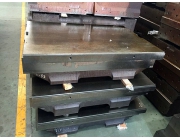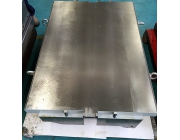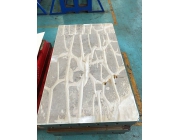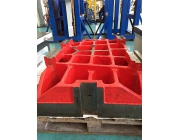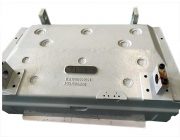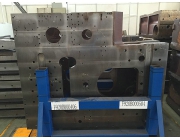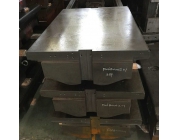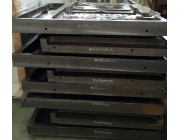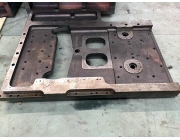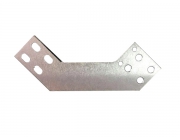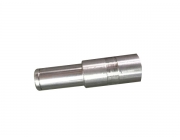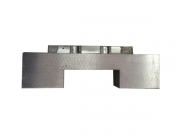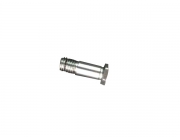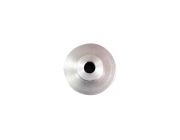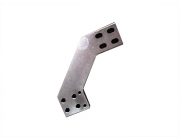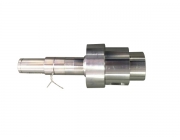The milling machine passes through the rotation of the tool and moves along the axis of the workpiece to finish the forming of the metal. Obviously, the milling machine is very important in the machining position.
Although milling machines are mainly used for machining flat and square surfaces, they are also used for many other purposes. Skilled technicians can use milling machines to cut angles, corners, boring holes, and to process arcs, semicircular arcs and spiral surfaces (using spiral tools — — double helix or multi spiral cutters) by using some auxiliary equipment of some milling machines. Some special cutting tools can also be used for machining gear teeth, dovetail grooves and T grooves on milling machines. More importantly, machining the workpiece shape on the milling machine can be done entirely manually without the need of CNC machining.
![src=]()
Now, if we use computer control to drive the spindle of the milling machine, the range of workpieces that can be machined will be larger. A computer-aided design / computer-aided manufacturing program is used to control the milling machine, and almost any workpiece can be machined. As long as it can be displayed on the computer screen, the shape of the workpiece can be basically processed by milling.
The operation of milling
The basic operations can be divided into four types:
(1) end milling — — cutting the plane with the end of the cutter teeth.
(2) copying cutting — — machining the shape of the workpiece with the side of the tool.
(3) drilling.
(4) boring — — forming an inner circular surface.
1. end end milling
The tool is located at the depth of the cutting part required below the workpiece surface, and then the workpiece is engaged with the cutter in a specific radial position, called radial engagement. The radial meshing is defined as the ratio between the length of the tool’s radial contact with the workpiece and its diameter. Face milling can be machined by three different milling cutters:
Face milling cutter:
This kind of cutting tool is specially made, the main material is high speed steel and hard alloy. Toothed carbide tools are by far the most commonly used in industry. The face milling cutter can achieve 64 of medium high fine grinding or achieve better accuracy.
End milling cutter:
Because their end and circumferential direction all have teeth, so this tool is used to cut the end of the end, and when the end teeth are used for grinding, the end milling cutter is vertically cut into the workpiece, similar to drilling, and the face milling cutter can’t be drilled. So when it is not in contact with the workpiece, it must be placed in DOC. End mills with 2 teeth or 4 teeth are very common, and 3 tooth end mills often use high-speed cutting metals, such as aluminum. A small number of end milling cutters are made of cobalt high speed steel, which has a higher hardness and toughness than the end milling cutter made of standard high speed steel, but the cost of cobalt cutting tools is more expensive. It is sometimes not reasonable to spend the extra cost of cobalt high speed steel, except when the hard alloy tool causes the cutting edge to be broken because of the mechanical vibration, and the ordinary high speed steel alloy is easily obtuse because of the hardness of the workpiece.
End mills are sometimes replaced by rigid and progressive tools. The cost is higher than that of high speed alloy steels, but the cutting speed is 3 times higher than that of high speed alloy steels. End mills are sometimes used in the form of toothed carbide. The end milling cutter can achieve medium finish. When machining the surface, it can match the face milling cutter at relatively low speed.
Flying knife:
Flying cutter is a kind of single tooth face cutter. Because of its low cutting speed, it is used for assembly work rather than in mass production. Flying must be placed very accurately on a flat or smoother surface. The high speed steel or carbide cutter head of the flying cutter is clamped with something similar to that of the lathe head. Although the flying knife is very cheap and can be bought in stores, its cutting speed is very slow and there is a serious safety hazard. The vibration and centrifugal force of the cutter flying to the outside end are noteworthy for flying cutter cutting.
2. weeks to cutting
Circumferential cutting (also called molding cutting) is defined as cutting the inner or outer surfaces of the workpiece with the side teeth of the tool. The most commonly used circumferential cutting tool is the end milling cutter. We should be wary of the direction of milling, it is necessary to know that the difference of force depends on the direction of the feed. When the edge teeth are cut, the cutting tool can move forward to the &mdash by the driving wheel along a certain path in the workpiece; — it is called the CIS milling. During milling, the rotation direction of the tool in the workpiece always causes the machining feed shaft and workpiece to pass through the cutting point. Or you can reverse the feed direction of the tool along the circumferential direction. The direction of the cutting teeth is opposite to the direction of the feed axis, which is called inverse milling. It is important to understand the difference between them for safety, service life and smoothness.
3. staircase and cavity machining
Plugged to cutting depth: a hole &mdash should be machined at the place of rough machining before the cavity is processed; — this operation is similar to a drill, called a pin, is done with a end milling cutter, and then the side of the milling cutter is used to process the cavity. The plunge milling process of milling cutter with three grooves or four grooves can be realized by proper grinding through one or more teeth of the center face. Most of the two groove milling cutters can be inserted and milling, but not all of them can be used. Some hollow cutting tools with no cutting edges can not plug and mill.
Cutting depth of oblique milling cutter: the cutting and milling of end milling cutter is called oblique milling or abbreviation milling. This method is not often used in manual operation. It is mainly used in NC machining, because it is more easy to discharge chip than direct drilling, and it can make the coolant directly reach the machining part. Spiral milling has a double advantage over straight line milling. First, it can prevent cutting tools from cutting the shape of the cavity, thus avoiding the machining marks on the machined surface, which is called helical oblique milling. The cutting tool is a spiral drop.
4. forming and cutting
Chamfering: chamfering is usually used in the cavity and outside with feet. The chamfering is usually referred to as the fillet. The tooth line of chamfering cutter has two kinds: concave and convex. Machining of workpieces in a lathe with a form milling cutter is called molding. There are two kinds of end mills for machining concave angle, they are ball ends and round end end mills.
Custom-made molding: when the machining shape is special, the simplest tool in the workshop is a flying knife, and its high speed steel blade can process any shape of the workpiece without special equipment.
5. drilling / reaming
6. boring

